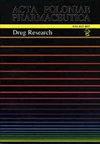喹硫平在药物过量治疗中氧化应激和炎症状态的参与
IF 0.4
4区 医学
Q4 PHARMACOLOGY & PHARMACY
引用次数: 0
摘要
喹硫平(QT)属于第二代抗精神病药物。它主要用于治疗抑郁症、双相情感障碍和精神分裂症。在通过髓过氧化物酶(MPO)的生物转化过程中,QT被氧化为喹啉和一种反应性自由基,这可能有助于中毒期间氧化应激的发展。共存的炎症也可能对QT中毒过程中的紊乱有显著影响。本研究对21例喹硫平中毒患者进行了检查。该研究旨在评估血液QT浓度与中毒患者血清中选定的氧化应激以及炎症生物标志物(如MPO和C反应蛋白(CRP)水平)之间的相关性。所获得的结果与由21名健康人组成的对照组的值有关,这些健康人未经治疗且未被药物中毒。血液中QT毒性浓度(3.15±2.11μg/mL)的患者血清MPO活性和CRP水平明显高于对照组。研究组的CRP平均水平为76.74 mg/L,而对照组仅为1.86 mg/L。QT过量后患者MPO活性和CRP血液水平的增加可能证实了其生物转化过程中产生的氧化障碍和伴随炎症的假设。证明了所选生物标志物与血液QT浓度、患者的临床状况和治疗类型之间具有统计学意义的关系。本文章由计算机程序翻译,如有差异,请以英文原文为准。
Participation of quetiapine in oxidative stress and inflammation status in the treatment of drug overdose
Quetiapine (QT) belongs to the second generation of antipsychotics. It is mostly used to treat depression, bipolar disorder, and schizophrenia. During biotransformation via myeloperoxidase (MPO) QT is oxidized to quinoneimine and a reactive radical, which may contribute to the development of oxidative stress during intoxication. The coexisting inflammation may also significantly contribute to the disturbances in the course of QT poisoning. In this study, twenty-one patients poisoned with quetiapine were examined. The study aimed to assess the correlation between blood QT concentration and selected oxidative stress as well as inflammation biomarkers, such as MPO and C-reactive protein (CRP) levels in the serum of poisoned patients. The obtained results were related to the values of the control group consisting of 21 healthy people, untreated and not poisoned with the drug. In patients with a toxic QT concentration in the blood (3.15 ± 2.11 μg/mL), the activity of MPO and CRP serum level were significantly higher in comparison to the control group. The mean level of CRP in the study group was 76.74 mg/L, while in the control group only 1.86 mg/L. The increase in MPO activity and CRP blood level in patients after QT overdose may confirm the hypothesis of oxidative disorders arising during its biotransformation and concomitant inflammation. Statistically significant relationships between selected biomarkers and blood QT concentration, the patient's clinical condition and the type of therapy were demonstrated.
求助全文
通过发布文献求助,成功后即可免费获取论文全文。
去求助
来源期刊
CiteScore
0.80
自引率
0.00%
发文量
74
审稿时长
6-12 weeks
期刊介绍:
The international journal of the Polish Pharmaceutical Society is published in 6 issues a year. The journal offers Open Access publication of original research papers, short communications and reviews written in English, in all areas of pharmaceutical sciences. The following areas of pharmaceutical sciences are covered: Analysis, Biopharmacy, Drug Biochemistry, Drug Synthesis, Natural Drugs, Pharmaceutical Technology, Pharmacology and General.
A bimonthly appearing in English since 1994, which continues “Acta Poloniae Pharmaceutica”, whose first issue appeared in December 1937. The war halted the activity of the journal’s creators. Issuance of “Acta Poloniae Pharmaceutica” was resumed in 1947. From 1947 the journal appeared irregularly, initially as a quarterly, then a bimonthly. In the years 1963 – 1973 alongside the Polish version appeared the English edition of the journal. Starting from 1974 only works in English are published in the journal. Since 1995 the journal has been appearing very regularly in two-month intervals (six books a year). The journal publishes original works from all fields of pharmacy, summaries of postdoctoral dissertations and laboratory notes.

 求助内容:
求助内容: 应助结果提醒方式:
应助结果提醒方式:


